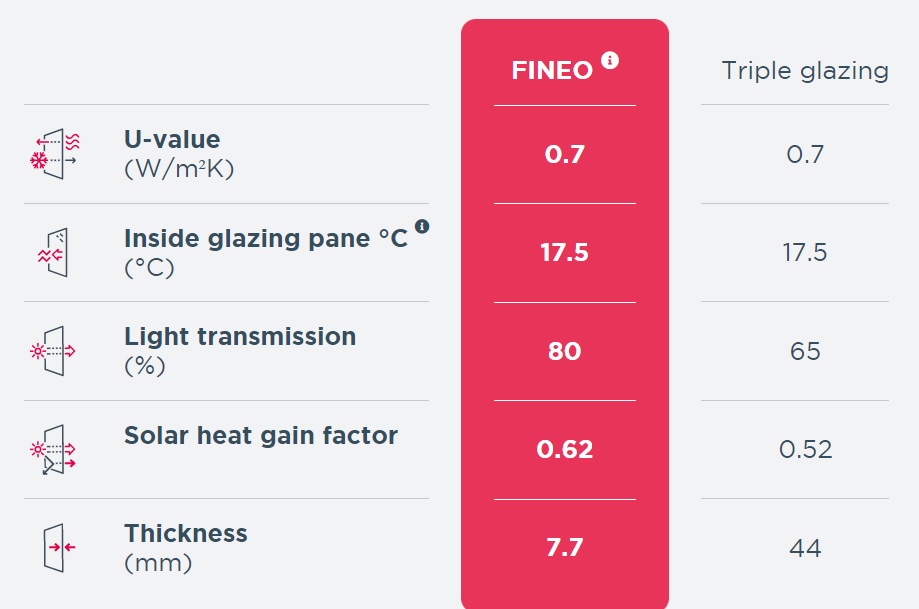Over the past week or so, a debate on Twitter, which has sometimes become slightly heated, has been raging about the use of vacuum insulated glass (VIG) products in order to achieve new proposed lower minimum u-values.
With focus on 2025 and the proposed Future Building Standards upending regulations once again, methods on how to achieve new minimum u-values are going to be up for debate.
What is vacuum insulated glazing?
Unlike traditional double or triple glazed IGU technology, vacuum insulated glazing, such as the Fineo product by AGC, takes two pieces of glass and uses just a 0.1mm gap between them. The glass can be between 3mm or 6mm thick, depending on the application. You can find out more about the various Fineo products and more about VIG here.
The reason why there is growing interest in VIG is due to the incredibly high performance of the product. In comparison to triple glazing, these are some of the key stats that VIG produces:

CREDIT: Fineo
Whilst both products can get to 0.7 in terms of u-value, it is the thickness, or lack thereof, of the glazing that VIG can reduce to which is grabbing the attention of the sector.
The technology isn’t new. It’s been around for over a decade. But with lower minimum u-values about to become reality, only now is it really becoming a product that is being explored by the UK market
The ultra-slim glazing profile is a primary USP of this technology. Whilst much of the sector look at triple glazing as the method of compliance for 2025, other parts of the sector that are hesitant towards triple glazing are looking for alternatives. This is one of them.
For me, VIG has to be something that we consider as a sector. We know that a lot of suppliers in the middle of the supply chain do not want to go down the road of triple glazing. The extra material, weight, cost and storage all present problems. VIG allows the sector to reach new lower minimum u-values without adding to weight to frames and hardware. From a “green” point of view, this product ticks a lot of boxes.
This isn’t to say that VIG is right for every scenario. The industry purchases a wide range of glass products and the likely outcome out of all of this is by the time we get to 2025 there is going to be a range of products and options that will allow installers to fit windows to the new standards. I believe most will look at triple glazing, but I do think some suppliers will start to look at VIG in a more serious way, so long as there is continued investment in the technology to expand it’s supply and perhaps for it to be made here in the UK and not just in Europe.
Cost barrier
The one point that has got people fired up on social channels is the issue around price. Whilst it is true to say that the cost of vacuum insulated glazing is higher then regular IGU technology so is triple glazing when compared to double glazing. If the industry is going to choose triple glazing as the preferred method of compliance with 2025 regulations, it is still going to have to spend millions on upgrading hardware, changing profile systems, adding more storage capacity, making more deliveries due to weight restrictions etc in order for it to work.
At the moment, VIG is more expensive than triple glazing. However, a portion of that cost is due to delivery from Europe. The key to making it cheaper is to make it at scale domestically. This is going to require the likes of Pilkington, Saint-Gobain or Guardian to invest in the production of the product here in Britain.
I am not aware whether this is something any of them are looking into at the moment, but if they are, I think this would be great news for the sector. If anything to at least provide a choice for end users who are ultimately the ones who are going to have to live with the product.
This industry on the whole buys on price more than anything else. At this moment, I believe the sector will choose triple glazing over anything else. Which will keep the spacer bar companies happy I am sure. But, if we find that VIG becomes more accessible in the UK and the cost per m2 reduces to something that compares with triple glazing, then the only genuine barrier to VIG is removed and then becomes a very compelling option for more of the sector to look at.
To get weekly updates from DGB sent to your inbox, enter your email address in the space below to subscribe:
By subscribing you agree to DGB sending you weekly email updates with all published content on this website, as well as any major updates to the services being run on DGB. Your data is never passed on to third parties or used by external advertising companies. Your data is protected and stored on secure servers.







You might need to change the name of your blog Jason! ;)
VIG Blogger? Doesn’t quite have the same ring to it!